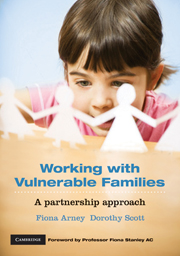Book contents
- Frontmatter
- Foreword
- Contents
- List of figures, tables and boxes
- Contributors
- Acknowledgements
- Introduction
- Chapter 1 Think child, think family, think community
- Chapter 2 Family strengths: an international perspective
- Chapter 3 Harnessing ‘resilience’ when working with children and families
- Chapter 4 Working within and between organisations
- Chapter 5 Family-centred practice in early childhood settings
- Chapter 6 Sustained nurse home visiting with families of Aboriginal children
- Chapter 7 Including fathers in work with vulnerable families
- Chapter 8 Parenting in a new culture: working with refugee families
- Chapter 9 Responding to parents with complex needs who are involved with statutory child protection services
- Chapter 10 Engaging family members in decision making in child welfare contexts
- Chapter 11 Supporting parents whose children are in out-of-home care
- Chapter 12 Using evidence-informed practice to support vulnerable families
- Chapter 13 Spreading promising ideas and innovations in child and family services
- Index
Introduction
- Frontmatter
- Foreword
- Contents
- List of figures, tables and boxes
- Contributors
- Acknowledgements
- Introduction
- Chapter 1 Think child, think family, think community
- Chapter 2 Family strengths: an international perspective
- Chapter 3 Harnessing ‘resilience’ when working with children and families
- Chapter 4 Working within and between organisations
- Chapter 5 Family-centred practice in early childhood settings
- Chapter 6 Sustained nurse home visiting with families of Aboriginal children
- Chapter 7 Including fathers in work with vulnerable families
- Chapter 8 Parenting in a new culture: working with refugee families
- Chapter 9 Responding to parents with complex needs who are involved with statutory child protection services
- Chapter 10 Engaging family members in decision making in child welfare contexts
- Chapter 11 Supporting parents whose children are in out-of-home care
- Chapter 12 Using evidence-informed practice to support vulnerable families
- Chapter 13 Spreading promising ideas and innovations in child and family services
- Index
Summary
The challenge of ending child abuse is the challenge of breaking the link between adults' problems and children's pain.
(UNICEF, A League Table of Child Maltreatment Deaths in Rich Nations, September 2003)This book is about working with vulnerable parents so that we might prevent child abuse and neglect and enhance the well-being of our children.
Who are ‘vulnerable families’? In this book, when we refer to families we are talking about children and the adults who care for them, be they mothers, fathers, grandmothers, grandfathers or other extended family members. If we are honest, all parents will acknowledge times when they have felt very vulnerable and their feelings of vulnerability have impacted upon family life. The birth of a child is a joyous event but brings with it a time of significant change and disruption to families as well as the need for adjustment which some parents may find overwhelming. Parents can also experience vulnerability when facing natural disasters such as fire or flood; stressful life events such as marital breakdown; the illness or death of a family member or friend; the loss of a job or eviction and so on. Life challenges such as these can over-whelm a family's ability to cope, but for some, it may also provide opportunities for growth and positive change.
All families differ in their ability to manage difficult challenges and have different internal and external resources to draw upon.
- Type
- Chapter
- Information
- Working with Vulnerable FamiliesA Partnership Approach, pp. 1 - 6Publisher: Cambridge University PressPrint publication year: 2010



